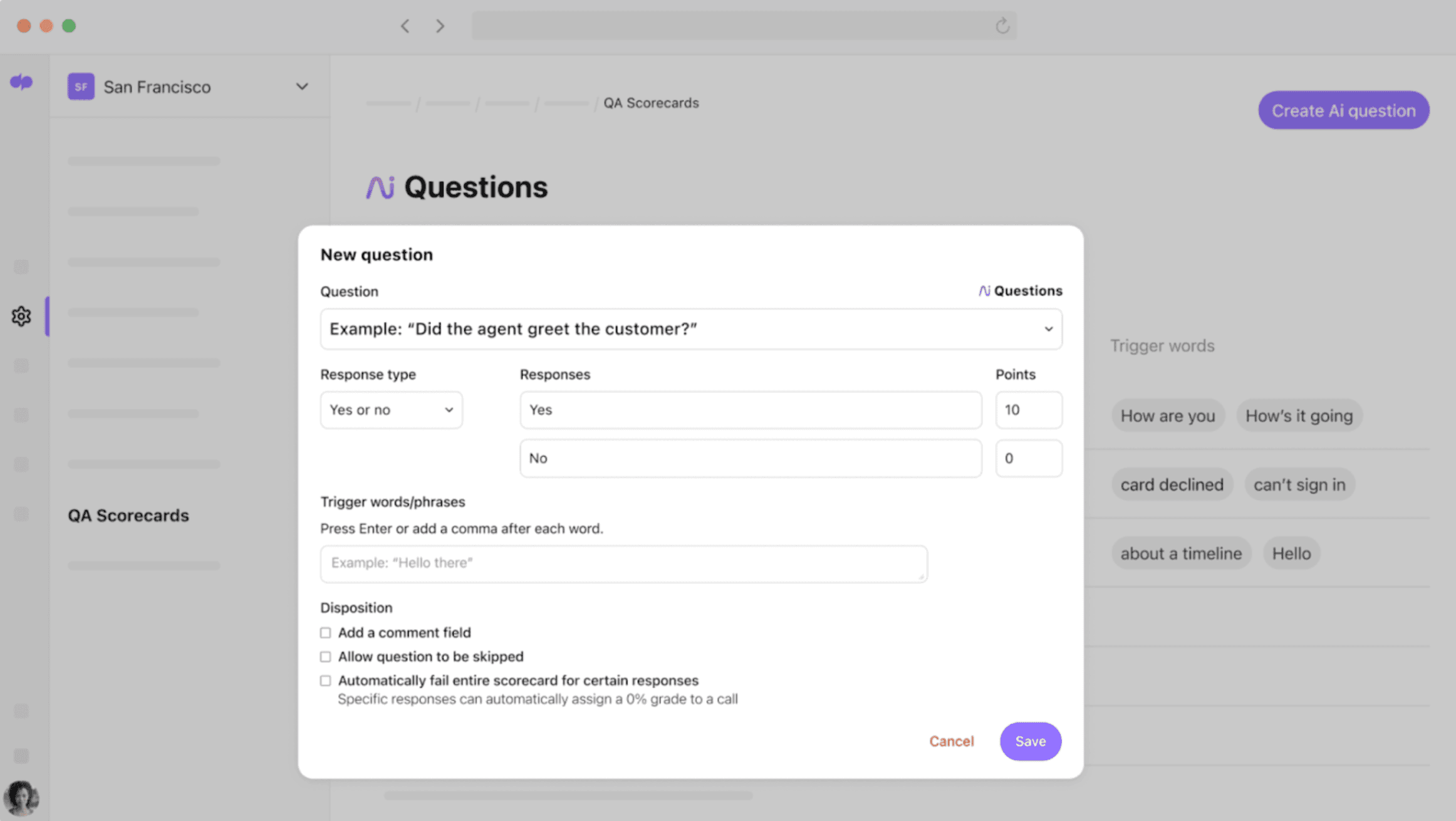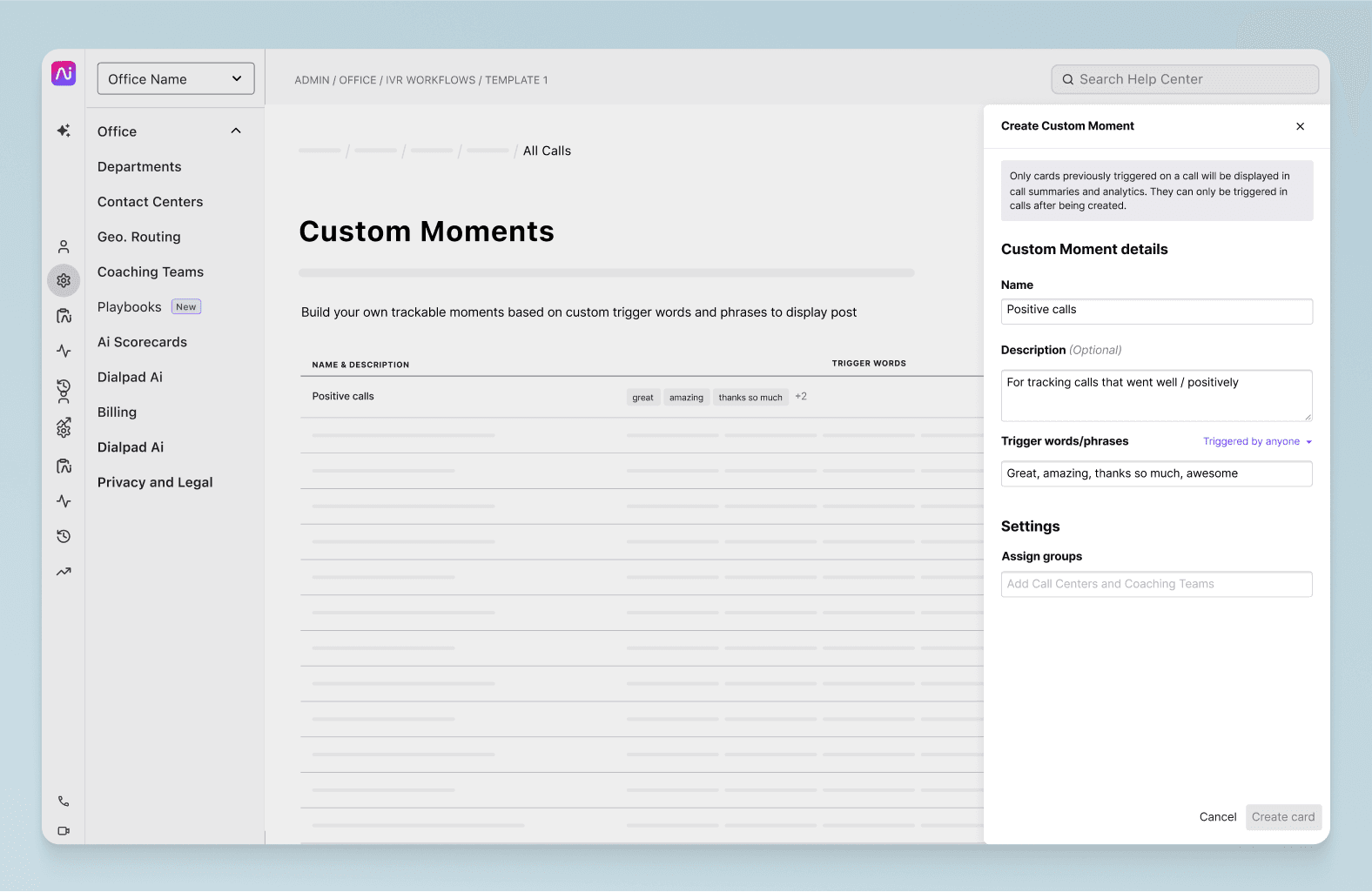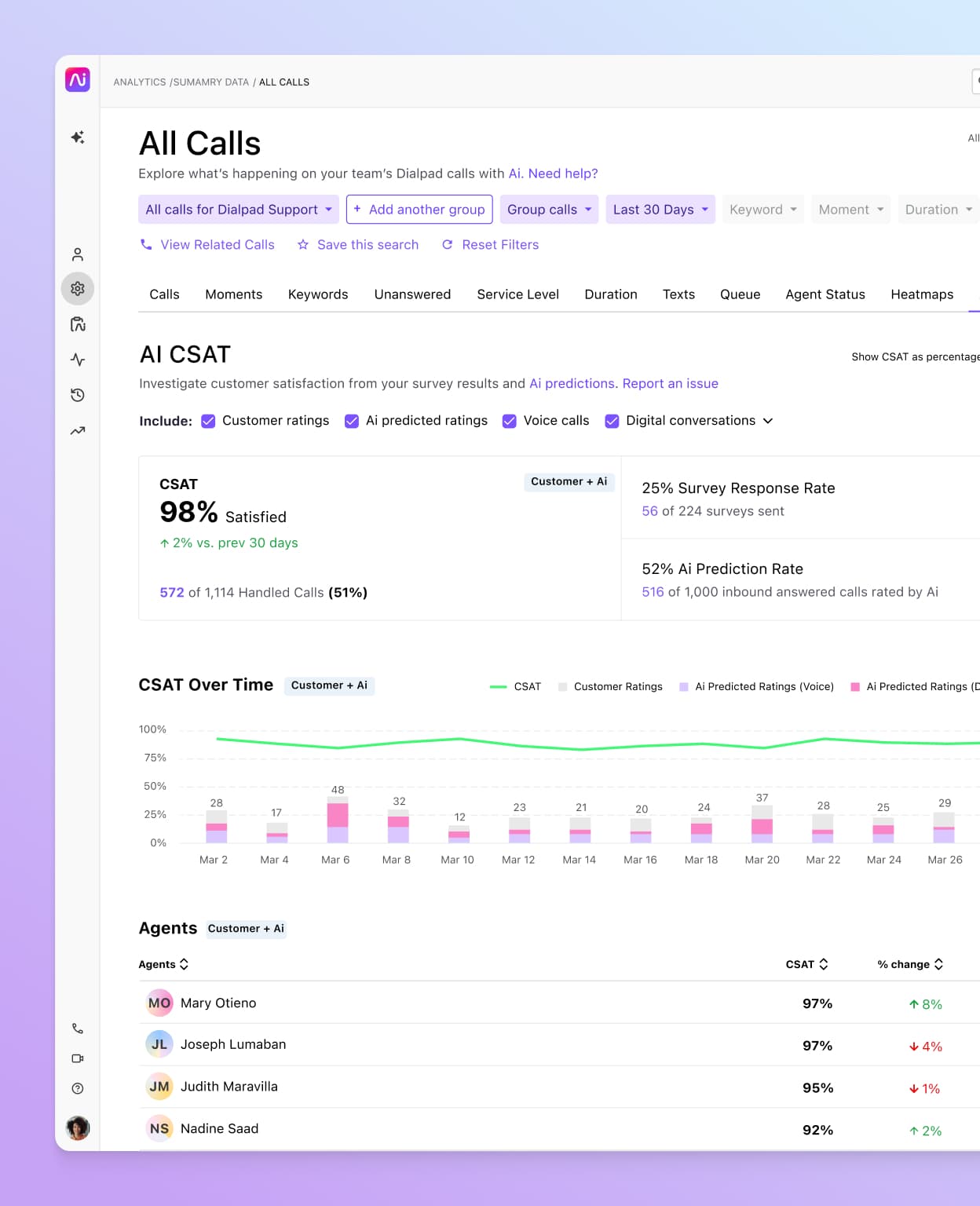Improve Call Center Customer Experience: 6 Tips

Sr. Customer Success Manager, Strategic Accounts

Share
Call center customer experience: How to deliver exceptional service
Call center customer experience plays a crucial role in determining a company's success. The data is clear: customers are more likely to stay loyal to brands that provide efficient, personalized, and positive service experiences.
In this blog post, we'll take a closer look at what call center customer experience is, why it matters, actionable tips for improving it, and ways to measure customer satisfaction.
What is a call center customer experience?
Call center customer experience refers to the interactions and overall experience a customer has when engaging with a company's call center.
This encompasses every step of the process, from the first point of contact to the resolution of the customer's issue. It includes how customers perceive their needs are being addressed, the professionalism and effectiveness of the agents, and how quickly and smoothly the process is carried out.
What is considered the call center experience?
There are typically several key aspects that the call center experience encompasses, including:
First contact resolution: How quickly and effectively an agent resolves the customer’s issue on the first interaction.
Agent professionalism: The behavior, tone, and skill level of the agent during the call.
Customer effort: How easy it is for customers to get their questions answered or issues resolved.
Response time: The speed with which a customer’s query or issue is handled.
Personalization: How well the interaction meets the individual needs of the customer.
The importance of customer experience in call centers
The customer experience in call centers is essential for several reasons. First, a positive contact center experience can significantly increase customer retention. When customers are happy with the service they receive, they’re more likely to stay loyal to your brand (and sometimes even recommend it to friends and colleagues). This loyalty not only fosters repeat business, but also attracts new customers through word-of-mouth referrals—at no cost to you.
On a related note, a company’s brand reputation is also closely tied to its call center service. A bad experience where customers don’t get the answers they need, or get repeatedly transferred back and forth between agents, can easily lead to scathing reviews on third-party sites and social media.
Because of this, providing good customer service gives you a competitive advantage, especially in a marketplace filled with similar products and services. A call center that delivers exceptional customer experiences can quickly distinguish your brand from competitors. Even when there are cheaper or more convenient alternatives available, customers are more likely to return to a company that consistently provides outstanding service.
Finally, a good call center customer experience has a direct impact on revenue growth. Loyal customers who are more satisfied with their interactions tend to spend more and provide valuable referrals, which contributes to further revenue growth.
According to McKinsey, improving the customer experience increases sales revenues by two to seven percent, profitability by one to two percent, and overall shareholder return by seven to 10 percent.
How to improve customer experience in a call center: 6 tips
By focusing on the right strategies, tools, and behaviors, you can create an environment that supports both your agents and your customers. Here are some actionable tips:
1. Leverage the latest call center technology
To help your agents provide a smooth and efficient customer experience, it’s crucial to invest in the latest call center technology. Specifically, look for contact center or call center software features like:
Omnichannel support: Use platforms that integrate all the communication channels you need (like phone calls, SMS/MMS messaging, website live chat, and social messaging) to provide a seamless customer experience across all touchpoints. Dialpad Support, for example, provides all of these channels in a single pane of glass—and because it’s part of the Dialpad ecosystem, it also provides internal collaboration features like team messaging:

Ai and chatbots: Ai-powered tools are vital for assisting customers with basic inquiries, which saves time and allows your agents to focus on more complex issues. They can act as internal-facing support tools to help your agents find the information they need instantly. Here’s a look at how Dialpad’s Ai Assistant connects with all your connected knowledge sources (like PDFs, FAQ pages, and even unstructured sources like past customer conversations) to pull helpful answers, links, and documents for agents live as they’re talking to customers:

Real-time data and analytics: A good platform should also highlight important data such as call center metrics and conversational insights in a clean dashboard for supervisors and call center managers.
2. Give agents regular, up-to-date training
Well-trained agents are the cornerstone of exceptional customer service. Providing regular training helps ensure your agents stay current with product knowledge, customer service techniques, and company policies. More importantly, it helps them address customer inquiries accurately and efficiently.
In addition to technical training, focusing on soft skills development is equally important. Training agents in emotional intelligence, active listening, and conflict resolution equips them with the tools to better handle customer concerns. These skills allow agents to empathize with customers, manage difficult situations, and create positive, personalized interactions that result in higher customer satisfaction.
Contact center platforms should come with tools that support managers with training. For example, Dialpad Support has Ai tools such as QA scorecards that can analyze customer calls and provide recommendations to supervisors about whether agents executed the actions they needed to. Supervisors can set the criteria they want to track, how it’s weighted, and more with just a few clicks:

By providing agents with regular, objective feedback on their performance, contact center leaders can help them learn from their successes and challenges, refine their skills, and ultimately deliver better service over time.
3. Analyze your call center data to drive improvements
Making data-driven decisions is essential to making consistent improvements to call center performance. You can use call center analytics to:
Track customer interactions to understand customer behavior and pain points. Some call center solutions have live sentiment analysis tools that track whether customer calls are going positively or negatively based on tone and the type of words being used. Here’s how it looks in Dialpad as an example:

Identify trends, common issues, or frequently asked questions to proactively improve customer support processes. Another useful Dialpad Ai is Custom Moments, which tracks how frequently certain keywords come up in conversations. For example, a manager can set up a Custom Moment to track “refund” or “talk to your manager.” Dialpad will then track how often these words are spoken on calls—if they notice any spikes or anomalies, they can dig into those conversations to learn more:

Monitor key metrics like First Call Resolution (FCR), Average Handle Time (AHT), and Customer Satisfaction (CSAT) to assess performance and identify areas for improvement. While some of these metrics are fundamental to most call center software, more modern platforms have unique workarounds that address the challenges of measuring certain metrics. For example, CSAT scores are extremely useful, but difficult to measure because typically only the angriest and happiest customers bother to fill out CSAT surveys. But Dialpad’s Ai CSAT feature, for example, can accurately predict CSAT scores for up to 100% of customer calls, which provides a more holistic and accurate view of customer satisfaction:

4. Automate repetitive tasks
Automating repetitive tasks not only reduces the workload on your agents and supervisors, but also improves accuracy and efficiency. Many call centers are already automating tasks like:
Call routing: Use intelligent routing systems to direct customers to the right agent or department automatically without needing someone to manually transfer them.
Self-service options: Implement self-service or Ai chatbots to give customers the option of resolving common issues, at any time of day, without waiting on hold to speak to an agent. Today, these Ai bots can do a lot more than just answering simple questions—they can also perform other tasks like updating account details or checking an order or delivery status.
CRM Integration: Connect your Customer Relationship Management (CRM) system to automate data entry and provide agents with real-time customer insights. For example, Dialpad Support has native integrations with CRMs like Salesforce, HubSpot, and Copper to let agents make calls from directly within the CRM and reduce time wasted on constantly toggling back and forth between different applications:

5. Provide a positive work environment for agents
Creating a positive work environment for your call center agents directly influences the customer experience—and is a key part of call center management. Happy, motivated agents are more likely to engage with customers positively, providing better service.
So, recognize the hard work your agents put in, offer them incentives, and maintain a supportive atmosphere. Regular team-building activities and an open feedback culture help agents feel valued and supported.
You can also look at more practical ways to make life easier for agents, such as scheduling shifts in a fair way. Dialpad WFM, for example, has an auto-scheduler feature that makes sure each agent gets the hours in their contract and that no one gets missed:

When agents feel respected and understood, they’re more motivated to perform at their best, which reflects in their interactions with customers, improves morale, and ultimately improves the overall customer experience.
6. Personalize the customer experience
Personalization goes beyond just addressing customers by name—it involves understanding their specific needs and preferences and tailoring the conversation accordingly.
A simple way to do this is by leveraging customer data and history to anticipate needs during interactions. A good CRM integration with your call center solution makes it easier for agents to track and store relevant customer details like previous issues, preferences, and past interactions, allowing agents to provide personalized solutions in real time.
How to improve your call center customer experience strategy
A clear and actionable strategy is key to achieving long-term improvements in call center customer experience. Here are a few ways to improve your strategy over time:
Set clear, adaptable objectives: Define your goals clearly with hard numbers where you can, whether it's reducing average handle time, improving first call resolution, or increasing customer satisfaction. More importantly, review these goals on an ongoing basis and adjust them as needed. (For example, if you’re an e-commerce business, you might expect much higher call and messaging volumes during the holiday rush.)
Regularly assess your strategies: Besides making adjustments based on data and feedback, this is also an opportunity to review agent training and onboarding materials and ensure that new hires are fully equipped to jump in and start handling customer inquiries.
Use customer feedback: Customer feedback is one of the most valuable types of information you have—and best of all, it’s free. Don’t waste it. Collect and act on customer feedback to fine-tune your products and service offerings. You can use surveys, social media, and other feedback mechanisms like Ai-powered conversational insights to learn about pain points and areas for improvement.
Measuring customer satisfaction and performance
Measuring customer satisfaction is essential for understanding the effectiveness of your call center. Some key metrics to track include:
Customer Satisfaction Score (CSAT) measures how satisfied a customer is after an interaction with your call center team.
Net Promoter Score (NPS) gauges customer loyalty and the likelihood that they would recommend your service to others.
First Call Resolution (FCR) tracks whether the customer’s issue was resolved on the first call.
Average Handle Time (AHT) measures the average time spent on each call and tells you whether agents are balancing efficiency with effectiveness.
Customer Effort Score (CES) assesses how easy or difficult it was for the customer to get their issue resolved.
Regularly reviewing these metrics helps pinpoint areas where your call center can improve its operations and customer interactions.
Improve your call center CX with Dialpad
Improving your call center customer experience is an ongoing process that requires the right combination of technology, training, data analysis, and automation.
By leveraging the latest technology, empowering your agents, analyzing performance, and implementing efficient strategies, you can elevate the customer experience in your call center and set your brand apart from your competitors.
See why global businesses like RE/MAX and Randstad use Dialpad Support to manage their call center operations.
Ready to uplevel your call center customer experience?
Book a demo with our team or take a self-guided interactive tour of the app on your own first!








